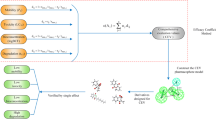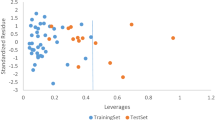Abstract
In this paper, a phthalic acid ester (PAE) three-dimensional quantitative structure-activity relationship (3D-QSAR) model with a double activity (toxicity and estrogenic activities) combination was established using a comprehensive evaluation method, in which the database of the combined activities consisted of 17 and 13 employed in the training sets and test sets, respectively. Ditridecyl phthalate (DTDP) derivatives with low-toxicity and estrogen combined activities were designed with DTDP as the target molecule. Four environmentally friendly DTDP derivatives were screened out by evaluating their environmental friendliness (expressed by persistence, bioaccumulation and migration) and practicability (expressed by insulation). Through the toxicity and estrogen single-activity model validation and contour map analyses, the results showed that the 3D-QSAR model for PAE toxicity and estrogen combined activities was feasible and the weight setting was reasonable. In addition, the mechanism analysis showed that the toxicity and estrogen combined activities of the four DTDP derivatives (2-CH3-DTDP, 2-OCHO-DTDP, 2-CH2COOH-DTDP, 2-CH2OH-DTDP) decreased in turn and were consistent with the single-activity model prediction. Meanwhile, it was speculated that the binding effect of the DTDP derivative molecules and estrogen-related proteins might be related to their hydrophobic interaction.






Similar content being viewed by others
References
Alexander, G., & Alexander, T. (2002). Beware of Q2. Journal of Molecular Graphics & Modelling, 20(4), 269–276.
Cai, Q. Y., Mo, C. H., Li, Y. H., Zeng, Q. Y., Wang, B. G., Xiao, K. E., Li, H. Q., & Xu, G. S. (2005). The study of PAEs in soils from typical vegetable fields in areas of Guangzhou and Shenzhen, South China. Acta Ecologica Sinica, 25(2), 283–288.
Chen, J. Y., Li, C., Luan, Y. X., Wang, J. H., & Lu, A. X. (2016a). Pollution characteristics and pollution level of phthalic acid ester in soils of facility vegetable bases of Beijing. Journal of Food Safety & Quality, 7(2), 472–477.
Chen, Y., Cai, X. Y., Jiang, L., & Li, Y. (2016b). Prediction of octanol-air partition coefficients for polychlorinated biphenyls (PCBs) using 3D-QSAR models. Ecotoxicology and Environmental Safety, 124, 202–212.
Cherkasov, A., Muratov, E. N., Fourches, D., Varnek, A., Baskin, I. I., Cronin, M., Dearden, J., Gramatica, P., Martin, Y. C., Todeschini, R., Consonni, V., Kuz’min, V. E., Cramer, R., Benigni, R., Yang, C. H., Rathman, J., Terfloth, L., Gasteiger, J., Richard, A., & Tropsha, A. (2014). QSAR modeling: where have you been? Where are you going to? Journal of Medicinal Chemistry, 57(12), 4977–5010.
Clarke, B. O., & Smith, S. R. (2011). Review of ‘emerging’ organic contaminants in biosolids and assessment of international research priorities for the agricultural use of biosolids. Environment International, 37(1), 226–247.
Davies, R. P., & Dobbs, A. J. (1984). The prediction of bioconcentration in fish. Water Research, 18(10), 1253–1262.
Heudorf, U., Mersch-Sundermann, V., & Angerer, J. (2007). Phthalates: toxicology and exposure. International Journal of Hygiene & Environmental Health, 210(5), 623–634.
Horn, O., Nalli, S., Cooper, D., & Nicell, J. (2004). Plasticizer metabolites in the environment. Water Research, 38(17), 3693–3698.
Huo, X. X. (2011) Studying on the electronic structure and transmission characteristics of small fullerenes. Dissertation, Jiangnan University.
Jia, P. P., Ma, Y. B., Lu, C. J., Mirza, Z., Zhang, W., Jia, Y. F., Li, W. G., & Pei, D. S. (2016). The effects of disturbance on hypothalamus-pituitary-thyroid (HPT) axis in zebrafish larvae after exposure to DEHP. PLoS One. https://doi.org/10.1371/journal.pone.0155762.
Kleinsasser, N. H., Wallner, B. C., Kastenbauer, E. R., Weissacher, H., & Harreus, U. A. (2001). Genotoxicity of di-butyl-phthalate and di-iso-butyl-phthalate in human lymphocytes and mucosal cells. Teratogenesis Carcinogenesis and Mutagenesis, 21(3), 189–196.
Liu, H. X., Shi, J. Q., Liu, H., & Wang, Z. Y. (2013). Improved 3D-QSPR analysis of the predictive octanol–air partition coefficients of hydroxylated and methoxylated polybrominated diphenyl ethers. Atmospheric Environment, 77, 840–845.
Net, S., Sempere, R., Delmont, A., Paluselli, A., & Ouddane, B. (2015). Occurrence, fate, behavior and ecotoxicological state of phthalates in different environmental matrices. Environmental Science & Technology, 49(7), 4019–4035.
Planello, R., Herrero, O., Martinez-Guitarte, J. L., & Morcillo, G. (2011). Comparative effects of butyl benzyl phthalate (BBP) and di (2-ethylhexyl) phthalate (DEHP) on the aquatic larvae of Chironomus riparius based on gene expression assays related to the endocrine system, the stress response and ribosomes. Aquatic Toxicology, 105(1), 62–70.
Pogribny, I., Tryndyak, V. A., Melnyk, S., Bagnyukova, T. V., Montgomery, B., & Rusyn, L. (2008). Mechanisms of peroxisome proliferator-induced DNA hypomethylation in rat liver. Mutation Research, 644(1), 17–23.
Qiu, Y. L., & Li, Y. (2018). A theoretical method for the high-sensitivity fluorescence detection of PAEs through double-substitution modification. Environmental Science and Pollution Research International, 25(34), 34684–34692.
Qiu, Y. L., Jiang, L., Zhang, S. J., & Li, Y. (2019). Molecular design of lower-estrogen-activity phthalate esters with high fluorescence intensity using pharmacophore model. International Journal of Environmental Analytical Chemistry. https://doi.org/10.1080/03067319.2019.1673742.
Qu, R. J., Liu, H. X., Feng, M. B., Yang, X., & Wang, Z. Y. (2012). Investigation on intramolecular hydrogen bond and some thermodynamic properties of polyhydroxylated anthraquinones. Journal of Chemical & Engineering Data, 57(9), 2442–2455.
Sheng, W., Wang, X., Wang, Z., & Na, X. L. (2015). Effects of soybean isoflavone and DEHP on the hormone level in female rats. Carcinogenesis Teratogenesis & Mutagenesis, 27(3), 216–220.
Singh, N., Dalal, V., Mahto, J. K., & Kumar, P. (2017). Biodegradation of phthalic acid esters (PAEs) and in silico structural characterization of mono-2-ethylhexyl phthalate (MEHP) hydrolase on the basis of close structural homolog. Journal of Hazardous Materials, 338(15), 11–22.
Tan, T. (2008) Modification on the interaction of drug with serum albumin by molecular spectroscopy. Dissertation, Chongqing University.
Wang, X. F., Yang, Y. J., Zhang, L. P., Ma, Y. B., Han, J., Yang, L. H., & Zhou, B. S. (2013). Endocrine disruption by di-(2-ethylhexyl)-phthalate in Chinese rare minnow (Gobiocypris rarus). Environmental Toxicology Chemistry, 32(8), 1846–1854.
Wang, X. L., Chu, Z. H., Yang, J. W., & Li, Y. (2017). Pentachlorophenol molecule design with lower bioconcentration through 3D-QSAR associated with molecule docking. Environmental Science and Pollution Research, 24(18), 25114–25125.
Wei, H. B., Pan, X., Xue, Y. B., Yang, Y., & Zhe, D. M. (2014). Simultaneous determination of 16 trace phthalate ester in plastic by gas chromatography-mass spectrometry. Plastics, 43(4), 43–53.
Wilkin, T. J., Metcalf, B. S., Murphy, M. J., Kirkby, J., Jeffery, A. N., & Voss, L. D. (2003). The relative contributions of birth weight, weight change, and current weight to insulin resistance in contemporary 5-year-olds: the EarlyBird Study. Diabetes, 51(12), 3468–3472.
Wittassek, M., Koch, H. M., Angerer, J., & Bruning, T. (2011). Assessing exposure to phthalates—the human biomonitoring approach. Molecular Nutrition & Food Research, 55(1), 7–31.
Wu, D. L., Xia, F. Y., Wang, C. H., & Zheng, P. (2004). Relationship between quantitative structure and biodegradability for phthalic acid ester compounds. Journal of Zhejiang University, 30(2), 141–146.
Xu, Y., Knipp, G. T., & Cook, T. J. (2006). Effect of di-(2-ethylhexyl)-phthalate and its metabolites on the lipid profiling in rat HRP-1 trophoblast cells. Archives of Toxicology, 80(5), 293–298.
Yang, F., Wang, M., & Wang, Z. Y. (2013). Sorption behavior of 17 phthalic acid esters on three soils: effects of pH and dissolved organic matter, sorption coefficient measurement and QSPR study. Chemosphere, 93(1), 82–89.
Yuan, B. L., Li, X. Z., & Graham, N. (2008). Aqueous oxidation of dimethyl phthalate in a Fe(VI)-TiO2-UV reaction system. Water Research, 42(6), 1413–1420.
Zhao, Z. H. (1991). Review of environmental and human health hazards of phthalate esters. Environmental Chemistry, 10(3), 64–68.
Zheng, B. Y., Huang, G. H., Liu, L. R., Guan, Y. R., & Zhai, M. Y. (2020). Dynamic wastewater-induced research based on input-output analysis for Guangdong Province, China. Environmental Pollution, 256, 1–11.
Zota, A. R., Calafat, A. M., & Woodruff, T. J. (2014). Temporal trends in phthalate exposures: findings from the National Health and Nutrition Examination Survey, 2001~2010. Environmental Health Perspectives, 122(3), 235–241.
Acknowledgements
We thank Wordvice (www.wordvice.cn) for its linguistic assistance during the preparation of this manuscript.
Funding
This study was funded by the Key Projects in the National Science and Technology Pillar Program in the Eleventh Five-Year Plan (grant number 2008BAC43B01).
Author information
Authors and Affiliations
Contributions
Conceptualization: Qing Li; Data curation: Qing Li; Formal analysis: Youli Qiu; Methodology: Qing Li; Project administration: Yu Li; Resources: Youli Qiu; Software: Qing Li; Validation: Yu Li; Writing of the original draft: Qing Li; Writing (review and editing): Yu Li
Corresponding author
Ethics declarations
Conflict of Interest
The authors declare that they have no conflict of interest.
Additional information
Publisher’s Note
Springer Nature remains neutral with regard to jurisdictional claims in published maps and institutional affiliations.
Rights and permissions
About this article
Cite this article
Li, Q., Qiu, Y. & Li, Y. Molecular Design of Environment-Friendly PAE Derivatives Based on 3D-QSAR Assisted with a Comprehensive Evaluation Method Combining Toxicity and Estrogen Activities. Water Air Soil Pollut 231, 194 (2020). https://doi.org/10.1007/s11270-020-04574-2
Received:
Accepted:
Published:
DOI: https://doi.org/10.1007/s11270-020-04574-2




